Wet Wet Wetlington
Wellington winter means lots of water. Falling from the sky, and then being all around us… and being all up in our face where we don’t want it. Aaaand we’re going to get it more intensely. So what can we do?
This is a repost (with minimal updates) of a Talk Wellington post by Kate Spencer
Well, hello there rain! How are you doing? Are you ready to surprise us again with your gifts of slips and floods and problems galore like in 2015 and 2017 and 2023 and…?
Excellent! Welcome, winter rains, welcome. *sarcasm
Fun facts
We know about rain, right? Weeeeell it seems we do and we don’t.
It falls. There’s no stopping it. And then it flows. Ain’t no stopping gravity either.
Rain flows downhill ‘til it can go no further: hopefully to the sea, where the water cycle (that one you learnt about in primary school) can continue.
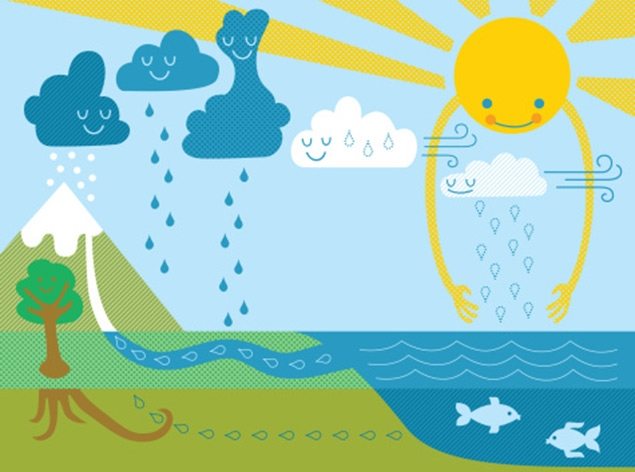
So far, so patronising – thanks, you say, I’m not seven.
But no, that’s not quite how it’s working out these days.
Thanks to our built-up, tarmac- and roofing- and concrete-covered landscapes, there ain’t much of that soaking in happening any more. Anywhere between 60 and 90% of what falls out of the sky can’t soak in any more – it has to flow over the land’s surface – that’s “stormwater”.
Kiwis’ traditional way, having waterproofed a bit of land, is to channel this runoff, collect it, divert it away – which is OK, and enables lots of nice diagrams like this below.
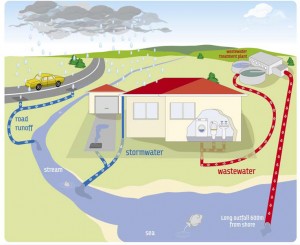
But when you keep waterproofing (i.e. developing) more and more of the land uphill, the same pipes at the bottom of the hills are trying to carry waaaaay more water every time it rains. And, bonus! Those lower-lying areas are where most of us we live and work and so on.
It doesn’t help when sumps (those grating things in the gutters) get blocked – though as the DomPost’s Dave Armstrong knows, emergency clearing of sumps is a nice occasion to get out and meet the neighbours (and/or get lynched by suggesting councils spend on other things).
But blocked sumps are the thin end of the problem we’re creating ourselves. The infrastructure is just becoming unable to cope with the sheer amount of water we’ve got descending on it all in a rush.
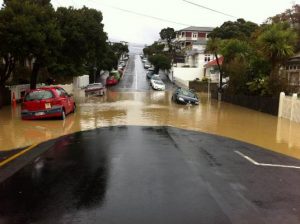
That gives us great situations like these pictures: when the rain runoff can’t flow, it just stays put and we’re flooded in no time at all
Sometimes only enough to reinvigorate the Taranaki St Puddle and be a pain for your shoes.
Sometimes it’s ankle or even surface, other times knee deep.
Sometimes just a pain for the road and the transport.
And sometime it’s in your bedroom, and the lounge, and the kids’ bedroom.
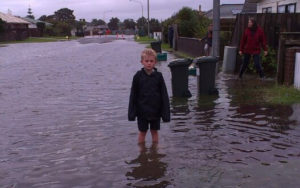
Coincidentally, that flooding hits many households already struggling with dampness and mould. Bonus!
And it’s only going to get worse. The cloud of climate change hangs over our heads. Our weather will become more extreme, with heavier downpours the norm.
(And this isn’t just thinking about the quantity of water – we’ve not even started to talk about its quality. This floody stuff – it’s not nice water. It’s not safe, clean, drinkable water; it’s stormwater. It’s untreated and it’s far too often contaminated with sewage. Our poo and pee, washing out into the coastline and harbours, inflicting grievous bodily harm on their mauri, further polluting our green and pleasant land (soon to be brown and not-so-pleasant)? Yeah, nah, New Zealand – we’re better than that.)
It’s gonna rain more, so what are we going to do?
Keep developing and waterproofing our uplands as we’ve traditionally done…. And just keep trying to build bigger pipes in our heavily-developed, high-value lowland areas to take all that extra runoff?
Here’s a crazy idea. How about we also try to make our urban areas more absorbent? There are some really simple steps we could all take.
Make your property less of a water liability
Roof collection tanks are a great start: they catch the first of rainfalls, so your roof’s runoff only starts going into the local drains once the tank’s filled. Collected water could then either be used as grey water (toilet flushing – rather common overseas, less so here to BRANZ’s frustration) or saved for emergencies (as WREMO are telling us to do for earthquake planning, this very week).
Help developers get onto it: tell them you’re the market and you want it!
Auckland are on it, blimmin’ Aucklanders. Auckland city are gradually implementing water sensitive design: an urban planning approach that integrates land use and freshwater management in a sustainable fashion.
But like anything, good practice needs to be taken up by those who actually develop and build.
Is water-savvy urban space a pipe dream (I’m really not sorry) or possible? Even the Auzzies are getting this sorted – and in some pretty wet areas like Melbourne too. It just takes market pressure: high-end subdivisions are already touting this.
Here’s a great little watch on how Berlin got started 25 years ago:
Swales: Not just good for rural highways
Swales, aka those ditches on the side of the road; but ditch seems a bit harsh given what an excellent asset they can be to a ‘Sponge City‘.

These little swales can absorb a lot of water and create threads of marsh habitat in the city. Look how at home it looks in the city environment
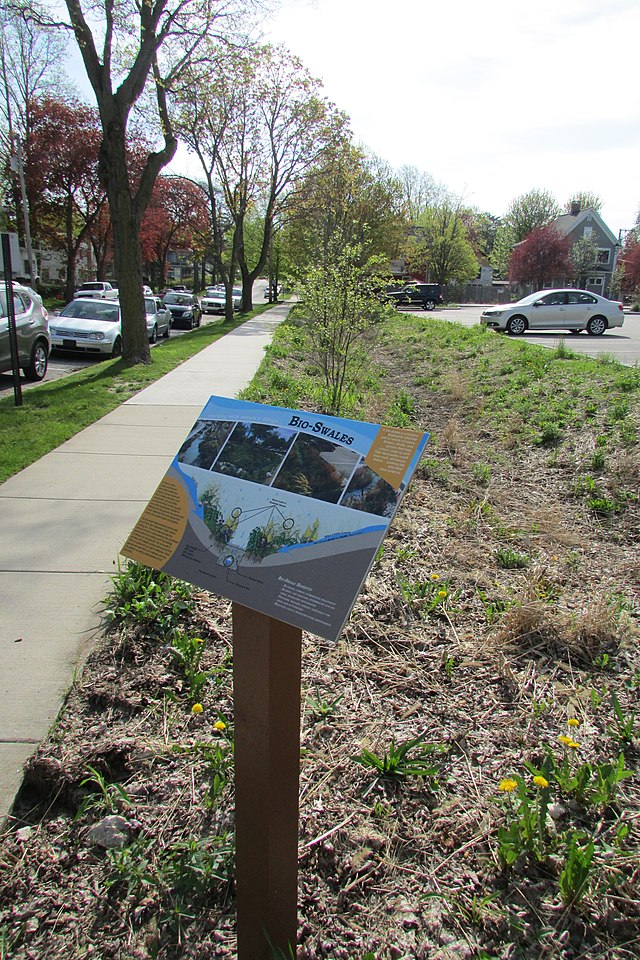
Make your city get onto it
Good practice for councils and Wellington Water (their water-managing organisation) also means integrated catchment management – a fancy term for “properly accounting for real world water, gravity, land and ecosystems rather than our conveniently segmented notions of them”). It’s a real departure from how we’ve traditionally done things in NZ. Therefore quite scary, and expensive, and there’s plenty of people probably saying “ooh that’s a bit crazy, let’s just take it step by step”.
We should be demanding this in Wellington.
We deserve – and as Dave points out, we need – solutions that look to the future, value nature, make our suburbs real assets – not public liabilities every time it rains a bit.
Yes please – in fact, yes, thank you very much, can we have this already!
Whaitua Committees are quietly trying to chip away at this, but the tough changes needed to our BAU will need commitment from politicians – and they’ll come asking us the ratepayers.
“No more waterproof developments, thanks”
So Wellington, as the winter rains kick in and our region gets soaked, a really good start would be committing ourselves to a better trajectory for how we develop land.
If we keep turning more of our hills from absorbent to waterproof when we make them habitable, we know we’re making a rod for our own backs – and more big expensive pipes sucking cash from our wallets just to try to keep our heads above water. Don’t make much sense.
- Tell your local politicians so – especially councillors. This is you doing some real water heroism for our region.
- Like a nice map? Check out Wellington City’s excellent data portal and see all the services underground. Handy step by step here!
- Getting sick of the ways we make industries out of “managing” problems we’ve created by ignoring nature? Here’s another approach: Coexistence
- Like a bit of DIY? Check you’ve not got a cross-connection (very very bad, yet very easy to do). 1000 water hero points for you!
Image credits:
- Banner Image: Rangituhi Crescent Porirua flooding 2015 – Stuff.co.nz
- Water cycle: Natgeokids.com
- Stormwater and sewer diagram: roundrocktexas.gov
- Flooded low point in Papawai Terrace, Mt Cook 2017 – by Jess Ewart via Dominion Post
- Kid in flooded street: Te-Kupe-Road-Paraparaumu-Beach-flooding-2015 -by-Krystal-Lane, RNZ
- Pukeko in swale: Doug Beckers
- Bio-swale: Chris Light
Leave a comment